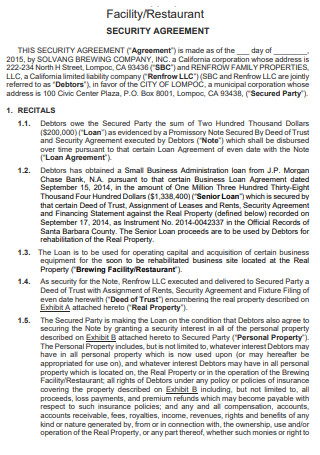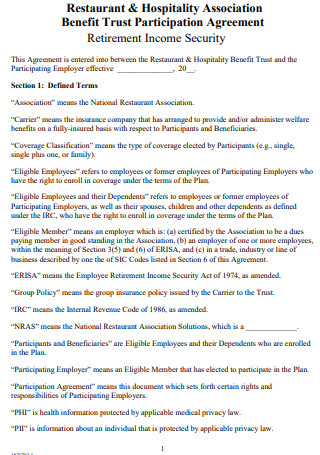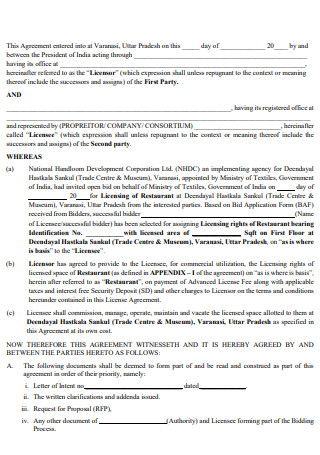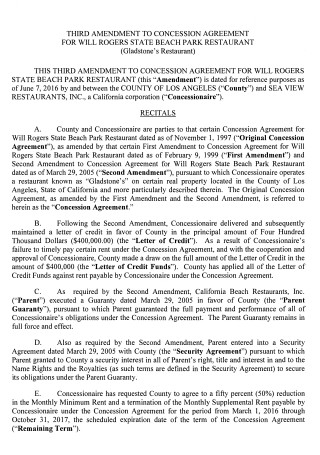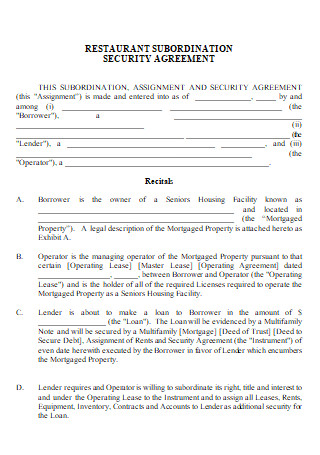4+ SAMPLE Restaurant Security Agreement
FREE Restaurant Security Agreement s to Download
4+ SAMPLE Restaurant Security Agreement
What Is a Security Agreement?
Benefits of Restaurant Smart Safes
Tips To Enhance Restaurant Security Measures
How To Own a Restaurant
FAQs
Are security agreements and a note identical?
How do you use a security agreement?
What is an information security clause?
What Is a Security Agreement?
A security agreement is a document that grants a lender a security interest in a pledged asset or property. When the security agreement is drafted, terms and conditions are defined. Creditors would not offer loans to certain businesses without security agreements. According to statistical evidence, the national restaurant association predicts a twenty percent success rate for all restaurants. Sixty percent of eateries fail within the first year of existence, and eighty percent within the first five years.
Benefits of Restaurant Smart Safes
Any restaurant’s objective is to promote efficiency, productivity, and profitability. Clients paying in cash for their meals frequently add a few more layers of complexity and danger. A high-tech smart safe has replaced the typical floor safe of yore with several features to help owners, managers, and staff save time by decreasing theft- and error-prone manual cash management processes. Here are numerous advantages that restaurants across the nation enjoy after investing in a smart safe:
Tips To Enhance Restaurant Security Measures
First and foremost, restaurant security is necessary to protect the health of both personnel and guests. Additionally, it is essential to safeguard the revenue of your organization. Most robberies are quiet. Without adequate restaurant security measures, money and kitchen goods could be stolen without your knowledge. Finally, adequate restaurant security is advantageous for insurance claims in the event of incidents. Recouping the costs of crimes is essential for the financial health of your business. If you’re curious, here are some suggestions for enhancing your restaurant’s security.
1. Provision of alcoholic beverages
Some of the violent crimes are alcohol-related. Therefore, there is a strong likelihood that this could pose a severe security risk to your business. Therefore, your bartenders and servers must be well-versed in serving alcohol responsibly. In several states, it’s unlawful to provide visibly intoxicated consumers alcohol. Additionally, it might result in customers behaving disorderly toward employees and fellow diners. TIPS alcohol training is a government-sponsored program that several states mandate restaurant staff to complete. Anyone who may serve or handle alcoholic beverages is required to complete this course. The training covers recommended practices for cutting off intoxicated consumers, calculating alcohol in mixed drinks, and examining customer identification cards.
2. Security control system
Certain areas of your restaurant require an access control system to ensure that only authorized individuals can enter. Numerous access control systems are available, so you must evaluate your access requirements, entry points, and budget before selecting one. Consequently, a keypad entry system is one of restaurants’ best access control solutions. Keypads are ideal for secondary entries and inner doors leading to restricted or staff-only areas. As the restaurant owner or chief administrator, you can determine which staff can access the rooms. Look for a keypad access control system that integrates with a mobile app when selecting one for your restaurant.
3. Safe cash management techniques
Most cash and payments will be processed through your POS system terminals. However, transferring money from these machines to your safe is associated with risks. Serious thieves conduct research before committing a crime; they will likely notice if you follow a pattern. Consequently, it would help if you transfer cash from POS terminals at different times throughout the day. Also, ensure that money is transferred often so that each POS terminal never accumulates excessive cash. Employees should never count money in front of guests as a general rule. In addition to possibly coming across as unpleasant, this could lead to someone estimating the average earnings of your establishment. Impulsive crimes are just as damaging as those committed by more strategic offenders. Additionally, develop a QR code menu so that your guests can order and pay online to save exchanging dollars.
4. Security cameras
How can a restaurant be secured most effectively? These convenient devices are the backbone of critical restaurant security measures. Surveillance cameras help curb theft, as well as violent and property offenses. Your restaurant’s security cameras will be most effective when positioned over high-value areas, such as the POS system, the bar, and any on-premises safes. It is also prudent to install surveillance cameras throughout the entire property, including the dining room. Your building’s exterior surveillance cameras can help dissuade or record after-hours intruders.
5. Employee verification
Before any employee begins working for you, your restaurant’s hiring procedure should include a comprehensive background check. If they have prior industrial expertise, they must contact their previous manager. If a former employee stole or was dishonest, they were likely terminated without criminal charges. Your code of conduct should include explicit guidelines regarding the beverages and meals employees are permitted to consume. In the employee training handbook for your restaurant, you should detail all parts of the cash management and tip pooling procedures.
6. Employee shift ending training
Training staff for the closing shift must be aware of the dangers associated with closing the restaurant. A buddy system should consistently be implemented when the lights go off and the POS cash registers have been emptied. Nobody should ever work the closing shift alone (yourself included). Include in your restaurant’s security checklist the locking of all doors leading to restricted areas, such as offices and storage rooms. In addition, you should instruct your personnel on how to secure all kitchen dangers, such as gas stoves.
7. Secure parking lot
Your restaurant’s security duties extend beyond the building’s entrance. Servers and bartenders are likely walking to their vehicles with their pockets stuffed with cash. Regardless of the neighborhood, this increases their likelihood of committing a violent crime due to the motivation alone. Therefore, ensure that your parking lot is well-lit. Consider assigning late-working workers parking places adjacent to the building, or at least close to one another. Following our recommendations for security cameras, you must monitor your parking lot with cameras.
How To Own a Restaurant
Owning and operating a restaurant is a fantasy job for many prospective entrepreneurs. It is a desire that may have been put on wait due to the epidemic, which led eateries to suspend indoor eating or possibly permanently lock their doors. Restaurant owners throughout the nation continue to feel the effects of the coronavirus as the industry fights to recover. The foodservice industry has adopted new restaurant trends and diversified revenue streams to weather the economic downturn. Many believe that restaurant ownership is still attainable, so we’ve compiled a checklist to help you get started. Beginning a restaurant involves meticulous planning and is more achievable when divided into steps. We have produced a seven-step guide to assist you if you want to learn how to open a restaurant.
1. Select a Restaurant Concept and Label.
If you’ve dreamed of launching your restaurant, you’ve likely given much thought to your restaurant’s concept. Choosing the idea for your business is the most enjoyable aspect of establishing a restaurant because it allows you to express your creativity. Your concept should contain the type of restaurant you intend to create, the cuisine you will provide, and the manner of service you will employ. Additionally, the interior of your restaurant should reflect your concept. Your restaurant’s brand is how you convey your restaurant’s objective and identity to the general public. Your restaurant’s name, logo, menu design, and products should share a unified brand image. The advertising channels you employ should also be highly influenced by the style and strategy of your business.
2. Make Your Menu Plans
The next creative stage in creating a restaurant is developing the menu. Choosing which menu items to highlight can be fun for any food, but prudent judgments should be made. Your menu will choose the type of equipment you’ll require, the talents you should search for in possible employees, and the kind of clientele you intend to attract. Consider your demographics as well. If you obtain a favorable lease in a college town, your restaurant’s menu should be geared toward college-aged clients. But if you insist on creating an expensive menu, you must select a place with a median personal income that can sustain higher pricing points. When finalizing your menu selections, use our menu design guide and pricing resource to produce a beautiful, profitable menu.
3. Write a Restaurant Business Plan
Any new business, including a restaurant, needs a good business plan. This step could be hard for people who don’t know much about business plans and how they are written. Business plans for restaurants are broken up into sections that describe every part of your new business, from the idea for the restaurant to how much money you will make. The plan aims to help you work out the details and give possible investors an overview of your business. When you try to get a loan for your restaurant, the restaurant business plan shows that your business will do well.
4. Obtain Restaurant Funding
The next step required to open a new restaurant is to secure financing. Most of us do not have the capital to operate a restaurant without financial aid. Obtaining finance from outside sources will influence if you can realize your dream of opening a restaurant. Start by determining the entire cost of opening a restaurant, as well as the cost of daily operations. Use this information to develop a budget and estimate your restaurant’s annual operating expenses.
5. Restaurant Permits and Licenses
Federal, state, and municipal permits and licenses will be required to open a new restaurant. When applying for restaurant permits and approvals, it is prudent to seek legal advice to ensure no steps are overlooked.
6. Plan Your Layout and Area
There are two aspects to consider when designing the layout of your new restaurant: the front-of-house and back-of-house areas. Every location has its specific requirements. Consider working with an enterprise specialist to produce a bespoke design plan that matches your demands if you require assistance.
7. Find a Supplier of Equipment and Food
Before you can open your new restaurant, you must equip the kitchen with the necessary supplies. Every restaurant requires specific equipment, such as refrigeration units and kitchen equipment. Depending on your menu, you may also need pizza deck ovens and pasta cookers. The size and architecture of your kitchen will influence some decisions, such as buying equipment with a shallow depth or double-stack cabinets to conserve space. Another factor to consider is whether to purchase new or used restaurant equipment. Purchasing restaurant equipment online offers numerous advantages. The flexibility to buy online, research features, and compare pricing on your own time alleviates some of the stress associated with launching your new restaurant. Find an internet retailer specializing in restaurant equipment, wholesale pricing, and expedited shipment. Leasing equipment is an alternative that can save you money and free up budgetary resources for other expenses.
FAQs
Are security agreements and a note identical?
Generally speaking, security agreements are used to supplement a secured promissory note. The note represents the borrower’s actual promise to return the borrowed funds. The enclosed security agreement presupposes the existence of an attached promissory message, which is not included in this package.
How do you use a security agreement?
Frequently, a business will acquire goods or equipment on credit and then utilize it as collateral. The debtor must authenticate the security agreement by writing an affidavit announcing the intention to issue a security interest in the specific property described in the security agreement.
What is an information security clause?
A clause in an employment contract notes the employer has the right to process data by the privacy notice and that the employee agrees to follow the employer’s data protection policy and other related policies.
Possessing this document may be difficult for you, particularly if you are creating it from the start, as it must comply with some legal requirements. To avoid this, you are strongly encouraged to utilize online resources to make your work simple, convenient, and of excellent quality. Then why are you still waiting? Use our templates immediately!

